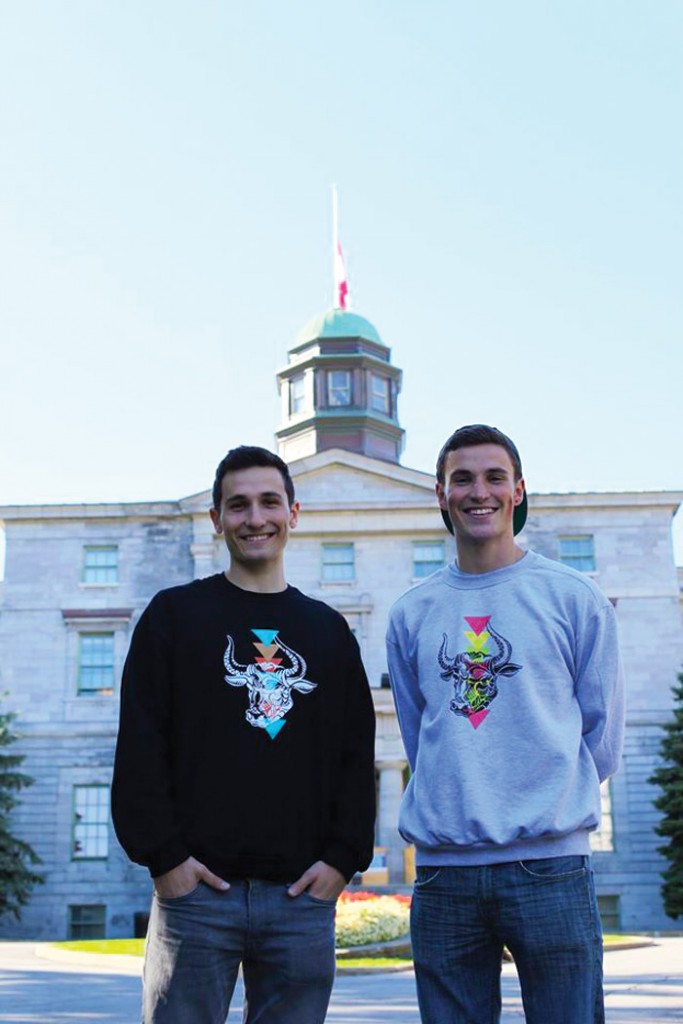In preparation for the camera crew, Matt Dajer and D’Arcy Williams had rearranged the furniture in Dajer’s small studio apartment. The bed went into the kitchen, and the desk was shifted to create a frame with Heart City Apparel’s merchandise in the background. Dajer and Williams, the two co-founders of the organization, had to ensure that the camera captured the company’s professionalism. By the time the reporters had finished framing the shot, the scene resembled that of a businesslike workspace. Dajer and Williams had, after all, invited the CBC reporters to Heart City Apparel’s office.
As young entrepreneurs without any financial backers, Dajer and Williams have had to work with their limited resources. When the duo launched Heart City Apparel in May 2014, Dajer had just graduated from McGill, and Williams was about to enter his last year as an international development studies major. The idea for the organization grew out of their appreciation for Montreal’s colourful street art, and their recognition of Montreal’s widespread homelessness.
“Heart City [Apparel] started from […] the beautiful street art of Montreal—which is just so plentiful—[combined] with a social cause that both [Dajer] and myself find truly important, and is usually overlooked a lot of the time,” Williams said. “When [Dajer] approached me with the idea, I couldn’t help but love the fact that it was a more local approach to giving back and helping.”
The company purchases designs from local street artists in cities around the world, and uses them to create clothing—at the moment, the organization offers sweatshirts and t-shirts—which are then sold to raise money for local charities that combat homelessness. Within Montreal, the company has worked with three artists, with money going towards Dans La Rue, a charity that provides resources for homeless youth. According to their website, Heart City Apparel has raised over $3,300 to date.
“Our main focus is on the youth, especially on the homeless youth,” Dajer said. “Dans La Rue has a cafeteria for the homeless [and] they have education for the homeless [….] I’ve gone to talk to the people who run Dans La Rue, and they say that even a couple thousand dollars can [help.]”
So far, the company has partnered with 10 artists from around the world, hailing from cities such as Chicago, Stockholm, and New Delhi. However, as a small organization that began without any credibility, Dajer and Williams had to start local by focusing on the talent within McGill and Montreal.
“In the beginning, we had a really good break where one of our first artists was Sarah Mehta, who’s a McGill student and a good friend of ours,” Williams said. “The second was Waxhead, [who] is one of the largest street artists in Montreal. That really boosted our legitimacy.”
In keeping with the company’s local identity, Dajer and Williams have also focused on marketing Heart City Apparel to local university students.
“Our entire market is pretty much 18- to 25- year- old college students who like social awareness campaigns […] fresh clothing, and affordable clothing,” Williams said.
At McGill, Heart City Apparel’s “College [Representative]” program has become a core part of the organization’s marketing and outreach efforts. As young entrepreneurs in their early 20s with minimal financial flexibility, Dajer and Williams’ marketing efforts have relied almost entirely on word of mouth initiatives and the efforts of their campus representatives. Tessa Battistin, a Heart City Apparel representative at McGill, cited the organization’s charitable focus and opportunity for marketing experience as reasons for her continued support of the company.
“I like how [Heart City Apparel] is helping charities, as well as doing something artistically,” Battistin said. “[As a representative,] you get experience if you like marketing, art, design, and any type of startup interest. It’s really good to learn from [Dajer and Williams]—they have a really good clue about what’s going on.”
With the organization expanding across the globe, Dajer and Williams are preparing to continue building their base of artists and charities, while further establishing Heart City Apparel’s brand.
“It’s been pretty fast growth so far,” Dajer said. “We’re considering eventually becoming more of a brand, so […] wherever our garment is made we give back to that city for example.”
“Going into the [U.S.] is really important,” Williams added. “I have so many friends from schools across the country that are interested. There is so much potential that is untapped—we just need to find a way to get there.”
In the midst of Heart City Apparel’s continued growth, both Dajer and Williams caution that they are focused on maintaining the company’s core vision.
“We’re trying to change the clothing industry […] for the better,” Dajer said. “It’s generally a pretty selfish industry, so it’s good to see more and more companies come up like this that are giving back.”









